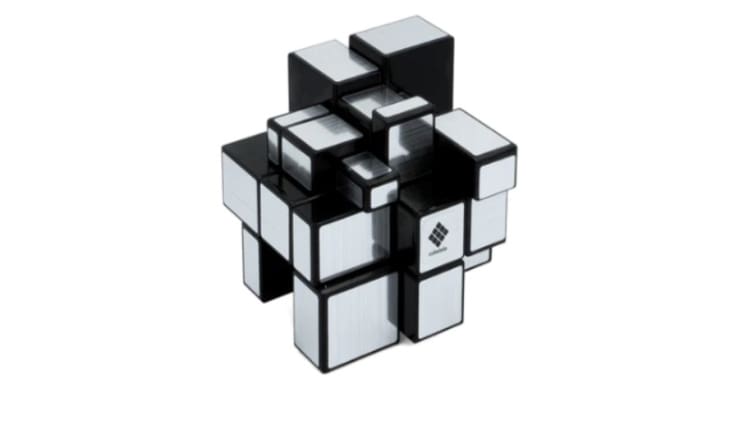The mirror cube, also known as the mirror 3×3 cube or the drift mirror cube, is a fascinating twist on the traditional Rubik’s Cube. With its reflective surfaces and unique symmetrical patterns, solving the mirror cube presents a new set of challenges and requires a different approach compared to the standard 3×3 cube.
In this article, we will delve into strategies that will help you master the art of solving the mirror cube 3×3 or qiyi cube 3×3 and unravel its captivating symmetrical complexities.
Understanding the Mirror Cube
Before diving into solving strategies, it’s essential to have a solid understanding of the mirror cube’s characteristics. The mirror cube is a shape-shifting puzzle that retains the same mechanism as the standard 3×3 cube. However, the drift mirror cube 3×3 introduces an additional layer of complexity with its symmetrical patterns and the reflection effect created by its mirrored stickers. Familiarize yourself with the cube’s structure, the unique movement of its pieces, and the reflection properties to gain a clear understanding of the puzzle’s mechanics.
Symmetry Recognition
Symmetry plays a crucial role in solving the mirror cube. By recognizing symmetrical patterns and configurations, you can effectively navigate through the solving process. Develop an eye for identifying symmetrical elements on the cube’s faces, such as symmetrical pairs of colors or specific mirror-image patterns. This skill will help you anticipate the effects of moves and plan your solving strategy accordingly.
Block-Building Techniques
Block-building techniques are instrumental in solving the mirror cube. Instead of focusing on solving individual pieces, block-building involves solving multiple pieces together as a block. Identify groups of pieces that share symmetrical relationships, and manipulate them as a unit. By doing so, you can maintain the cube’s symmetry throughout the solving process and avoid disrupting its reflective patterns.
Reflection Algorithms

Reflection algorithms are specialized algorithms designed for solving specific symmetrical patterns in the mirror cube. These algorithms are optimized to preserve the cube’s reflection effect and maintain its symmetry. Learning and practicing these reflection algorithms will greatly enhance your solving speed and efficiency. Familiarize yourself with algorithms that address common symmetrical configurations, such as mirrored L-shapes or T-shapes, and incorporate them into your solving repertoire.
Adaptation and Experimentation
Solving the mirror cube requires adaptability and a willingness to experiment with different approaches. Embrace the challenge of the mirror cube’s symmetrical complexities and be open to trying new solving techniques. As you gain more experience and develop a deeper understanding of the puzzle, you’ll be able to adapt your strategies to different symmetrical patterns and find innovative solutions to complex configurations.
Visualization and Planning
Visualization is a powerful tool when solving the mirror cube. Before executing moves, take a moment to visualize the effects on the cube’s symmetry. Plan your moves strategically, considering how they will impact the reflection patterns and maintaining the cube’s symmetrical structure. Developing strong visualization skills will enable you to solve the mirror cube with greater efficiency and accuracy.
Practice and Persistence
Mastering the mirror cube requires practice and persistence. Dedicate regular time to solving the puzzle, focusing on improving your speed and solving techniques. As you continue to practice, you’ll become more adept at recognizing symmetrical patterns, applying reflection algorithms, and navigating through the cube’s challenges. Embrace the learning process, stay motivated, and celebrate your progress along the way.
Additional Strategies for Mirror Cube Solving
Aside from the techniques discussed above, there are other strategies you can employ to improve your mirror cube solving skills. Here are some additional tips:
Stay calm and focused. Solving a mirror cube can be challenging, but it’s important to stay calm and focused throughout the process. Don’t rush or panic when you encounter a difficult pattern.
Use algorithms to your advantage. Learning algorithms is crucial to solving the mirror cube quickly and efficiently. Practice using them repeatedly until they become second nature.
Look for patterns. While mirror cube patterns may seem random at first, there are often repeating patterns that you can identify and use to your advantage. Take note of these patterns and try to anticipate the next move.
Experiment with different grips. The mirror cube can be solved using a variety of grips, so experiment with different ones to find what works best for you. Some cubers prefer a more relaxed grip, while others find a tighter grip helps them with their accuracy.
Practice regularly. Consistent practice is key to mastering the mirror cube. Set aside time each day or week to work on your mirror cube solving skills.
Learn from others. Don’t be afraid to seek advice and guidance from other mirror cube solvers. Join online communities, watch tutorials, and attend competitions to learn from experienced cubers.
Conclusion
Solving the mirror cube is a rewarding endeavor that requires a unique set of strategies and approaches. By understanding the cube’s characteristics, recognizing symmetrical patterns, employing block-building techniques, utilizing reflection algorithms, and embracing adaptability and visualization, you can master the art of solving the mirror cube. Through practice and persistence, you’ll develop the skills to solve this fascinating puzzle with speed and precision.

